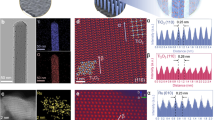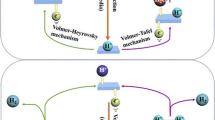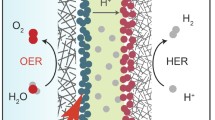Abstract
Oxygen evolution reaction (OER) is the main factor limiting the large-scale development of proton-exchange membrane (PEM) hydrogen production. It is urgent to develop catalysts with excellent OER catalytic performance and stability. Herein, several Iridium-based catalysts were prepared by simple mixing and calcination, the OER properties of catalysts with different melting points of nitrates as calcinating additives were investigated. The RbNO3 treated catalyst displayed a low overpotential(η) of 297.6 mV versus RHE, which is lower than the catalyst calcinated without nitrate (323.8 mV vs. RHE). Moreover, the RbNO3 treated catalyst displayed good acid stability over 20 h Chronopotentiometric test. The high OER catalytic activity and stability of RbNO3 treated catalyst may be attribute to the smaller nanoparticle morphology, pure IrO2 structure and high electrochemical surface area (ECSA), which increase the number of active sites and the intrinsic catalytic activity. This work indicated that the catalyst with excellent OER performance can be obtained by selecting nitrate with moderate melting point as the calcinating additive. Nitrates (like RbNO3) treated catalyst with excellent catalytic activity and stability has good application prospect in hydrogen production of PEM water splitting.
You have full access to this open access chapter, Download conference paper PDF
Similar content being viewed by others
Keywords
1 Introduction
Hydrogen energy [1,2,3] is a kind of renewable energy, which has the advantages of high energy density, environmental protection and pollution-free, so it has obtained the support of a number of national policies. At present, hydrogen production by proton-exchange membrane (PEM) electrocatalytic water splitting is regarded as a promising technical route. However its practical application is influenced by the slow kinetics [4, 5] of the oxygen evolution reaction (OER). Hence, it’s urgent to develop catalysts with excellent OER performance.
Among OER catalysts, Iridium components are widely studied because of the good catalytic activity as well as acid stability. There are various IrO2 preparation method such as Adams Fusion method [6, 7], sol-gel method [8, 9], liquid reduction method [10], template method [11] and so on. Adams Fusion method is a traditional method having the advantages of simple preparation process and low cost, but the catalyst’s overpotential prepared by this method is relatively high compared with other method [7]. Traditional Adams Fusion method mixes metal chloride precursor with NaNO3 and then calcinate at proper temperature, NaNO3 acts as an oxidation in the formation of new oxides. The presence of chlorine in the precursors can adversely affect PEM, and many studies have shown that chlorine-contained precursor should be avoided in future work to get rid of Cl− contaminations [12]. Catalyst with nano size often shows better catalytic performance. With the increase of calcinating temperature, the grain grows [13, 14]. Research [15] shows that the addition of salt has effect on crystal growth. In consequence, inspired by above researches, several nitrates with different melting points (low melting point nitrate: Fe and La nitrate; middle melting point nitrate: Na and Rb nitrate; high melting point nitrate: Mg and Ba nitrate) were introduced to control grain size. After simple mixing and calcination with Ir black, Iridium based catalysts were prepared.
In this work, we have developed an innovative additive oxidation process that on the one hand effectively inhibits particle size growth during calcinating and on the other hand extends the raw material from harmful chloride precursor to iridium black. The properties of different catalysts were studied by electrochemical measurement, and the reasons for the differences were explored by a series of characterization methods.
2 Experimental
2.1 Catalysts Preparation
The catalysts were prepared by mixed drying and calcination. Firstly, the nitrate and iridium black (Premetek, P40V40) were weighed at a mass ratio of 20:1, after which 20ml deionized water was added for ultrasonic mixing for 30 min. Then the solvent was evaporated and dried, the resulting mixture was placed in a crucible and transferred to a furnace with a temperature control system. The calcinating treatment was performed at 600 ℃ for 6 h with a heating time of 3 h. The obtained product was centrifuged, washed with deionized water three times, and then dried at 80 ℃ in a drying oven for 12 h. For comparison, the sample prepared by direct calcination without adding nitrates was used as the contrast.
2.2 Physical Characterization
X-ray diffraction (XRD) data were collected on a Rigaku D/MAX 2500 X-ray diffractometer equipped with a Cu Kα source. The morphology and compositions of the samples were examined by scanning electron microscopy (SEM, SU8020) and transmission electron microscopy (TEM) on a Tecnai G2 F30 configured with scanning transmission electron microscopy (STEM).
2.3 Electrochemical Analysis
The electrochemical performance (activity and stability) was performed in a typical three-electrode system by using CHI 660E instrument. The catalyst ink was prepared by adding 10 mg catalyst, and 100 μL Nafion (Alfa Aesar, D520 dispersion) into 1 mL ethanol and then ultrasonicating for 30 min. A certain amount of ink was loaded on the surface of the pre-polished glassy carbon electrode (GCE, φ3.0 mm) or carbon paper for drying, and the load of the catalyst is 0.5 mg cm−2. A catalyst-modified GCE or carbon paper was used as the working electrode, and a Pt wire and a saturated calomel electrode (SCE) electrode were used as the counter and reference electrodes, respectively. A 0.5 M H2SO4 solution was chosen as the electrolyte, and oxygen was bubbled into the electrolyte for at least 30 min to reach saturation before testing. The saturated calomel electrode was calibrated by the reversible hydrogen electrode (RHE), giving their conversion equation: E(RHE) = E(SCE) + 0.059PH + 0.24 V. The current densities are normalized by the geometric area.
3 Results and Discussion
3.1 Structural Characterizations
Figure 1 shows the X-ray diffraction (XRD) patterns of the nitrate treated catalysts and the contrast. As can be seen from the figures, different phases were formed after calcinating with nitrates with different melting point ranges. As the temperature rises, the crystalline water is removed first at a relatively low temperature and then the decompose of nitrate occurs, the melting point of anhydrous nitrates is shown in the Table 1. As for the NaNO3 and RbNO3 treated catalyst and the contrast, the diffraction peaks correspond well to IrO2 phase (PDF No. 43-1019, tetragonal, P42/mnm, and a = b = 4.4983 Å, c = 3.1544 Å). Additionally, with the addition of nitrates, XRD diffraction peak widened. As for low melting point Fe(NO3)3·9H2O and La(NO3)3·6H2O, IrO2 was observed, but the main phase is Fe2O3 for Fe(NO3)3·9H2O treated catalyst and La(OH)3 for La(NO3)3·6H2O treated catalyst. For high melting point nitrates, Ba(NO3)2 treated catalyst contains IrO2 and BaIrO2.73 phase, and Mg(NO3)2·6H2O treated catalyst has IrO2 and Ir phase. The XRD results proved that different structure may be formed by introducing different melting point nitrate. By introducing nitrates with appropriate melting points, pure IrO2 can be synthesized.
The SEM images of the synthesized catalysts are shown in Fig. 2. As can be seen from the figures, the contrast showed a nanoparticle morphology. After adding sodium nitrate and rubidium nitrate with moderate melting points, the size of the particles is reduced. In order to further explore the morphology of catalyst, TEM and HRTEM images are shown in Fig. 3. Same as the morphology that observed by SEM, NaNO3, RbNO3 treated catalyst and the contrast has the morphology of nanoparticle, the average particle size of RbNO3 and NaNO3 treated catalyst is about 8 and 11 nm, which is smaller than the contrast (about 16 nm). The HRTEM images of the two catalysts revealed a lattice fringe spacing of 0.318 nm, which correspond to the (1 1 0) plane of IrO2, which further verified the formation of pure IrO2.
3.2 Electrochemical Characterizations
To investigate the OER performance, the catalysts treated with several nitrates and the contrast were applied as anodic materials in a three-electrode system in 0.5 M H2SO4. The mass loading of all samples is 0.5 mg cm−2. The OER activities of all catalysts were evaluated by LSV with 85% iR-compensation. As shown in Fig. 4(a), catalyst treated with RbNO3 displayed a low overpotential(η) of 297.6 mV at 10 mAcm−2, which is lower than that of contrast (323.8 mV). Figure 4(b) gives the OER activity at 1.55 V (vs. RHE), the current density of RbNO3 treated catalyst is the highest, about 3 times higher than that of the contrast one. And Nitrates of Fe and La have almost no catalytic performance, which may because the calcinated material is basically oxide or hydroxide.
Tafel slope is a vital parameter for evaluating catalytic activity, as can be seen in Fig. 4(c) (the data is obtained from the LSV plots), these catalysts can be roughly divided into two classes according to the tafel value. Different tafel slope indicates that the catalyst has different rate‐determining step (RDS) [16]. The contrast and RbNO3 treated catalyst have a tafel slope approach 40 mV/dec, the NaNO3 treated catalyst has a tafel slope about 60 mV/dec. The RbNO3 treated catalyst’s slope is much lower, which indicates a fast reaction kinetics. Moreover, cyclic voltammetry (CV) curves were constructed at different scan rate to obtain double-layer capacitance (Cdl), further evaluate electrochemical surface area (ECSA). RbNO3 treated catalyst has a larger Cdl (73.32 mF cm−2) than the contrast (23.52 mF cm−2), implying the RbNO3 treated catalyst has more active sites [17]. Due to that ECSA is a parameter to reflect intrinsic activity of the catalyst, it can conclude that RbNO3 treated catalyst has a larger intrinsic catalytic area. Catalysts prepared with nitrates at different melting points showed different OER catalytic performance, RbNO3 and NaNO3 with moderate melting points are more superior, probably because they really act as calcinating aids at the calcinating temperature of 600 ℃.
In addition to electrocatalytic activity, stability is another crucial parameter to evaluate the performance of the catalyst. The stability of RbNO3 treated catalyst and the contrast were recorded by a chronopotentiometry technique. As can be seen in Fig. 5, the RbNO3 treated catalyst is extremely stable during the 20 h test at 10 mAcm−2, having a smaller voltage rise rate than the contrast. Chronopotentiometry test results indicated that the RbNO3 treated catalyst has a good stability in acid media.
4 Conclusion
To summarize, we synthesized Iridium-based catalyst by introducing several nitrates with different melting point. The simple mixing and calcinating process makes the preparation of iridium-based catalysts easier for industrial operation. By introducing different melting point nitrates, different crystal structure characteristics were produced, which affected the performance of OER. The results revealed that the as-prepared catalysts exhibited different OER catalytic activity. The addition of moderate melting point nitrates facilitated the formation of pure IrO2, achieving a low overpotential, especially for RbNO3 (η = 297.6 mV vs. RHE). Meanwhile, RbNO3 treated catalyst showed a long-term stability of 20 h. Sufficiently good catalytic activity and stability of RbNO3 treated catalyst may attribute from the smaller nanoparticle morphology and high ESCA. This work put forward an innovative chlorine-free method to prepare high OER performance iridium-based catalyst, which can be well used in the acid media like PEM water splitting and other energy device applications.
Change history
25 April 2024
A correction has been published.
References
Midilli, A., Ay, M., Dincer, I., Rosen, M.A.: On hydrogen and hydrogen energy strategies. Renew. Sustain. Energy Rev. 9(3), 255–271 (2005)
Sherif, S.A., Barbir, F., Veziroglu, T.N.: Wind energy and the hydrogen economy—review of the technology. Sol. Energy 78(5), 647–660 (2005)
Dincer, I.: Technical, environmental and exergetic aspects of hydrogen energy systems (2002)
Zhou, Z.-H., Sun, W., Zaman, W.Q., Cao, L.-M., Yang, J.: Highly active and stable synergistic Ir–IrO2 electro-catalyst for oxygen evolution reaction. Chem. Eng. Commun.Commun. 205(7), 966–974 (2018)
Chen, S., et al.: Mn-doped RuO2 nanocrystals as highly active electrocatalysts for enhanced oxygen evolution in acidic media. ACS Catal.Catal. 10(2), 1152–1160 (2019)
Liu, Y., Wang, C., Lei, Y., Liu, F., Tian, B., Wang, J.: Investigation of high-performance IrO2 electrocatalysts prepared by Adams method. Int. J. Hydrogen Energy 43(42), 19460–19467 (2018)
Song, S., Zhang, H., Ma, X., Shao, Z., Baker, R.T., Yi, B.: Electrochemical investigation of electrocatalysts for the oxygen evolution reaction in PEM water electrolyzers. Int. J. Hydrogen Energy 33(19), 4955–4961 (2008)
Ardizzone, S., et al.: Physico-chemical characterization of IrO2–SnO2 sol-gel nanopowders for electrochemical applications. J. Appl. Electrochem.Electrochem. 39(11), 2093–2105 (2009)
Villullas, F.I.M.-C.H.M., Nascente, P.A.P., Bulhoes, L.O.S.: Sol-Gel Prepared Pt-Modified Oxide Layers: Synthesis,Characterization, and Electrocatalytic Activity (2006)
Lee, S.W., Baik, C., Kim, D.-H., Pak, C.: Control of Ir oxidation states to overcome the trade-off between activity and stability for the oxygen evolution reaction. J Power Sour 493 (2021)
Li, G., et al.: A hard-template method for the preparation of IrO(2), and its performance in a solid-polymer-electrolyte water electrolyzer. Chemsuschem 5(5), 858–861 (2012)
Wang, L., et al.: Improving the activity and stability of Ir catalysts for PEM electrolyzer anodes by SnO2: Sb aerogel supports: does V addition play an active role in electrocatalysis? J. Mater. Chem. A 5(7), 3172–3178 (2017)
Huang, F., et al.: Insight into factors influencing thermal oxidation of iridium oxide electrode: thermostatic post-treatment temperature. J. Electrochem. Soc. 169(3) (2022)
Daiane Ferreira da Silva, C., et al.: Oxygen evolution reaction activity and stability benchmarks for supported and unsupported IrOx electrocatalysts. ACS Catalysis 11(7), 4107–4116 (2021)
Wang, Y., Mumford, K.A., Shen, S., Li, Y.: Effects of low-melting temperature salt (Na2SO4) addition on the phase transformation, crystal growth, and chroma of titanium dioxide pigments. Powder Technol. 284, 204–209 (2015)
Liu, Y., et al.: Iridium-containing water-oxidation catalysts in acidic electrolyte. Chin. J. Catal.Catal. 42(7), 1054–1077 (2021)
Huang, H., et al.: Equilibrated PtIr/IrO(x) atomic heterojunctions on ultrafine 1D nanowires enable superior dual-electrocatalysis for overall water splitting. Small 18(20), e2201333 (2022)
Acknowledgements
This material is based in part upon work supported by the State Grid Corporation of China Science and Technology Funding Project: Research and experimental verification of current density increasing technology for PEM electrolyzer (5419-202158490A-0-5-ZN).
Author information
Authors and Affiliations
Corresponding author
Editor information
Editors and Affiliations
Rights and permissions
Open Access This chapter is licensed under the terms of the Creative Commons Attribution 4.0 International License (http://creativecommons.org/licenses/by/4.0/), which permits use, sharing, adaptation, distribution and reproduction in any medium or format, as long as you give appropriate credit to the original author(s) and the source, provide a link to the Creative Commons license and indicate if changes were made.
The images or other third party material in this chapter are included in the chapter's Creative Commons license, unless indicated otherwise in a credit line to the material. If material is not included in the chapter's Creative Commons license and your intended use is not permitted by statutory regulation or exceeds the permitted use, you will need to obtain permission directly from the copyright holder.
Copyright information
© 2024 The Author(s)
About this paper
Cite this paper
Deng, J. et al. (2024). The Preparation of Iridium-Based Catalyst with Different Melting Point-Metal Nitrate and Its OER Performance in Acid Media. In: Sun, H., Pei, W., Dong, Y., Yu, H., You, S. (eds) Proceedings of the 10th Hydrogen Technology Convention, Volume 1. WHTC 2023. Springer Proceedings in Physics, vol 393. Springer, Singapore. https://doi.org/10.1007/978-981-99-8631-6_6
Download citation
DOI: https://doi.org/10.1007/978-981-99-8631-6_6
Published:
Publisher Name: Springer, Singapore
Print ISBN: 978-981-99-8630-9
Online ISBN: 978-981-99-8631-6
eBook Packages: Physics and AstronomyPhysics and Astronomy (R0)









